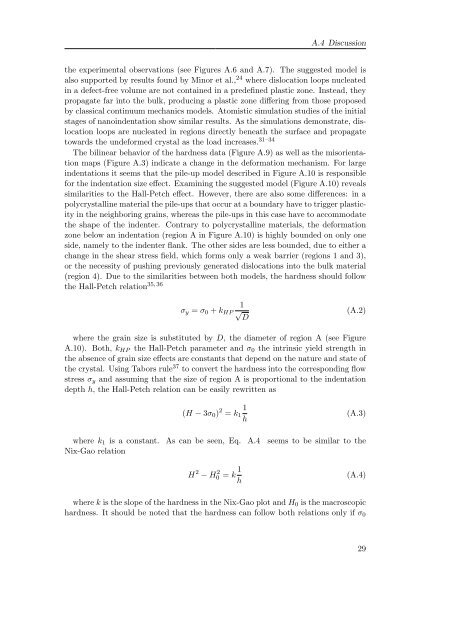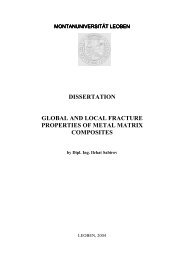Structural Investigation of Size Effects in Plasticity using Indentation ...
Structural Investigation of Size Effects in Plasticity using Indentation ...
Structural Investigation of Size Effects in Plasticity using Indentation ...
Create successful ePaper yourself
Turn your PDF publications into a flip-book with our unique Google optimized e-Paper software.
A.4 Discussion<br />
the experimental observations (see Figures A.6 and A.7). The suggested model is<br />
also supported by results found by M<strong>in</strong>or et al., 24 where dislocation loops nucleated<br />
<strong>in</strong> a defect-free volume are not conta<strong>in</strong>ed <strong>in</strong> a predef<strong>in</strong>ed plastic zone. Instead, they<br />
propagate far <strong>in</strong>to the bulk, produc<strong>in</strong>g a plastic zone differ<strong>in</strong>g from those proposed<br />
by classical cont<strong>in</strong>uum mechanics models. Atomistic simulation studies <strong>of</strong> the <strong>in</strong>itial<br />
stages <strong>of</strong> nano<strong>in</strong>dentation show similar results. As the simulations demonstrate, dislocation<br />
loops are nucleated <strong>in</strong> regions directly beneath the surface and propagate<br />
towards the undeformed crystal as the load <strong>in</strong>creases. 31–34<br />
The bil<strong>in</strong>ear behavior <strong>of</strong> the hardness data (Figure A.9) as well as the misorientation<br />
maps (Figure A.3) <strong>in</strong>dicate a change <strong>in</strong> the deformation mechanism. For large<br />
<strong>in</strong>dentations it seems that the pile-up model described <strong>in</strong> Figure A.10 is responsible<br />
for the <strong>in</strong>dentation size effect. Exam<strong>in</strong><strong>in</strong>g the suggested model (Figure A.10) reveals<br />
similarities to the Hall-Petch effect. However, there are also some differences: <strong>in</strong> a<br />
polycrystall<strong>in</strong>e material the pile-ups that occur at a boundary have to trigger plasticity<br />
<strong>in</strong> the neighbor<strong>in</strong>g gra<strong>in</strong>s, whereas the pile-ups <strong>in</strong> this case have to accommodate<br />
the shape <strong>of</strong> the <strong>in</strong>denter. Contrary to polycrystall<strong>in</strong>e materials, the deformation<br />
zone below an <strong>in</strong>dentation (region A <strong>in</strong> Figure A.10) is highly bounded on only one<br />
side, namely to the <strong>in</strong>denter flank. The other sides are less bounded, due to either a<br />
change <strong>in</strong> the shear stress field, which forms only a weak barrier (regions 1 and 3),<br />
or the necessity <strong>of</strong> push<strong>in</strong>g previously generated dislocations <strong>in</strong>to the bulk material<br />
(region 4). Due to the similarities between both models, the hardness should follow<br />
the Hall-Petch relation 35,36<br />
σy = σ0 + kHP<br />
1<br />
√ D<br />
(A.2)<br />
where the gra<strong>in</strong> size is substituted by D, the diameter <strong>of</strong> region A (see Figure<br />
A.10). Both, kHP the Hall-Petch parameter and σ0 the <strong>in</strong>tr<strong>in</strong>sic yield strength <strong>in</strong><br />
the absence <strong>of</strong> gra<strong>in</strong> size effects are constants that depend on the nature and state <strong>of</strong><br />
the crystal. Us<strong>in</strong>g Tabors rule 37 to convert the hardness <strong>in</strong>to the correspond<strong>in</strong>g flow<br />
stress σy and assum<strong>in</strong>g that the size <strong>of</strong> region A is proportional to the <strong>in</strong>dentation<br />
depth h, the Hall-Petch relation can be easily rewritten as<br />
(H − 3σ0) 2 1<br />
= k1<br />
h<br />
(A.3)<br />
where k1 is a constant. As can be seen, Eq. A.4 seems to be similar to the<br />
Nix-Gao relation<br />
H 2 − H 2 0 = k 1<br />
h<br />
(A.4)<br />
where k is the slope <strong>of</strong> the hardness <strong>in</strong> the Nix-Gao plot and H0 is the macroscopic<br />
hardness. It should be noted that the hardness can follow both relations only if σ0<br />
29
















